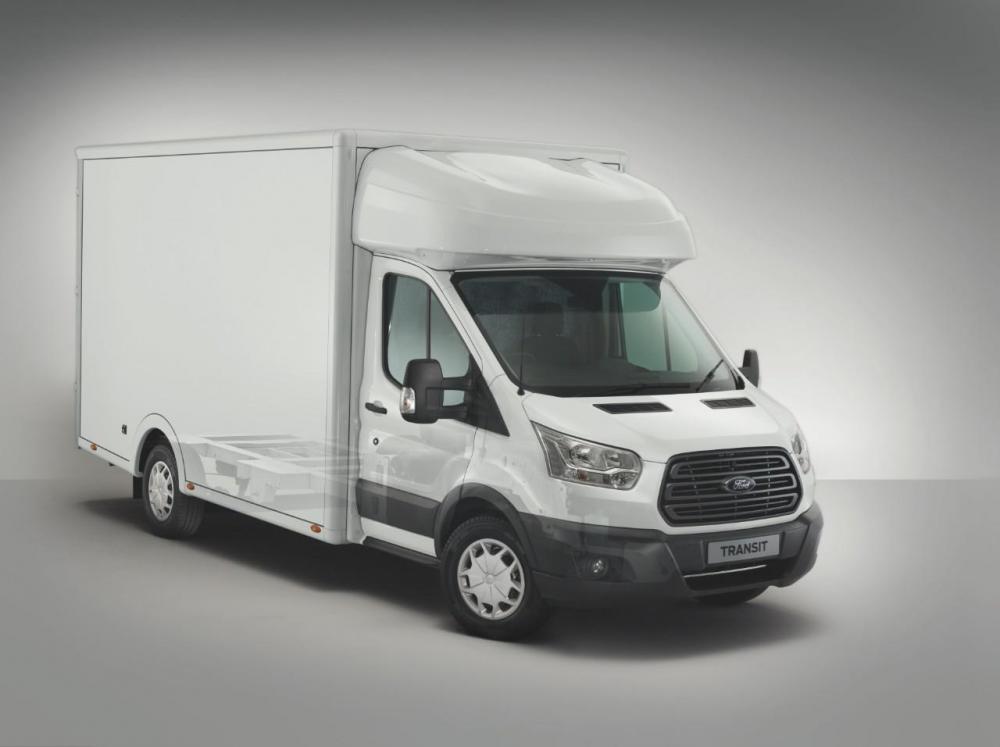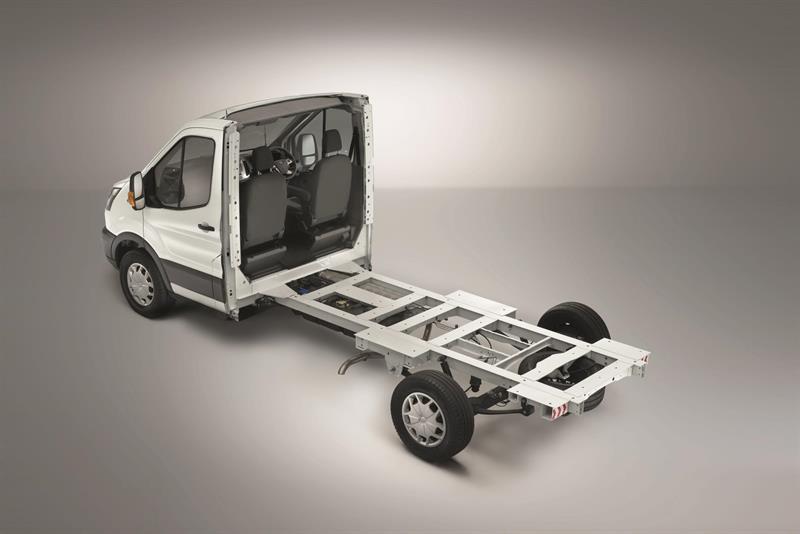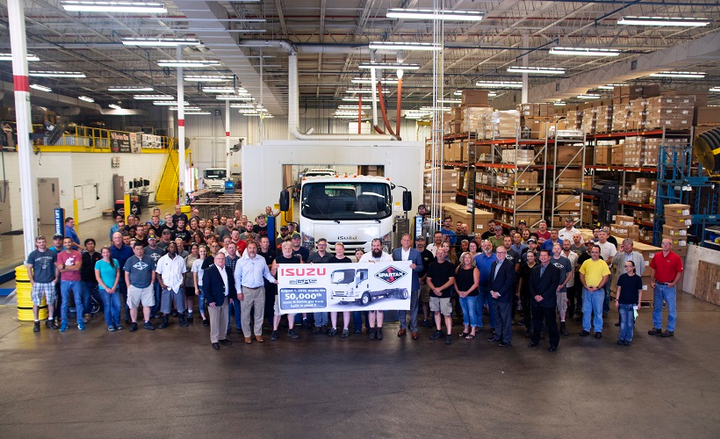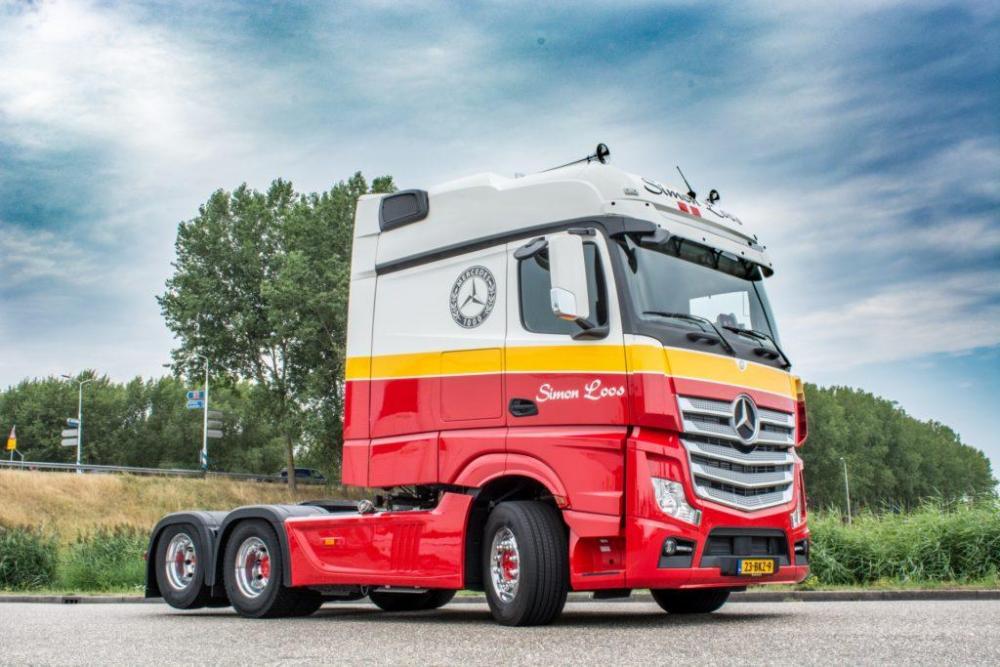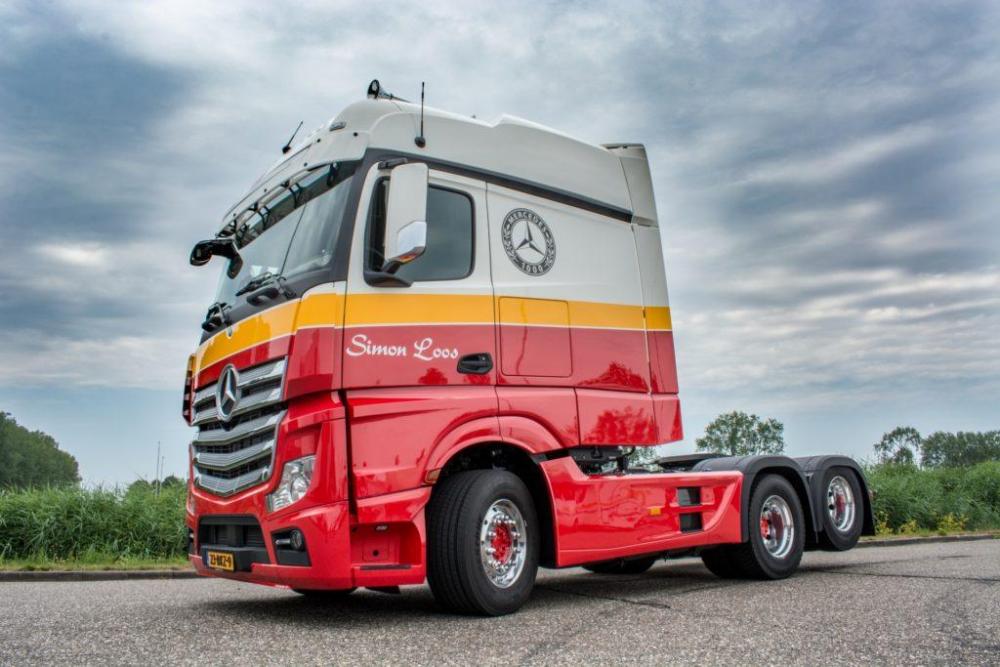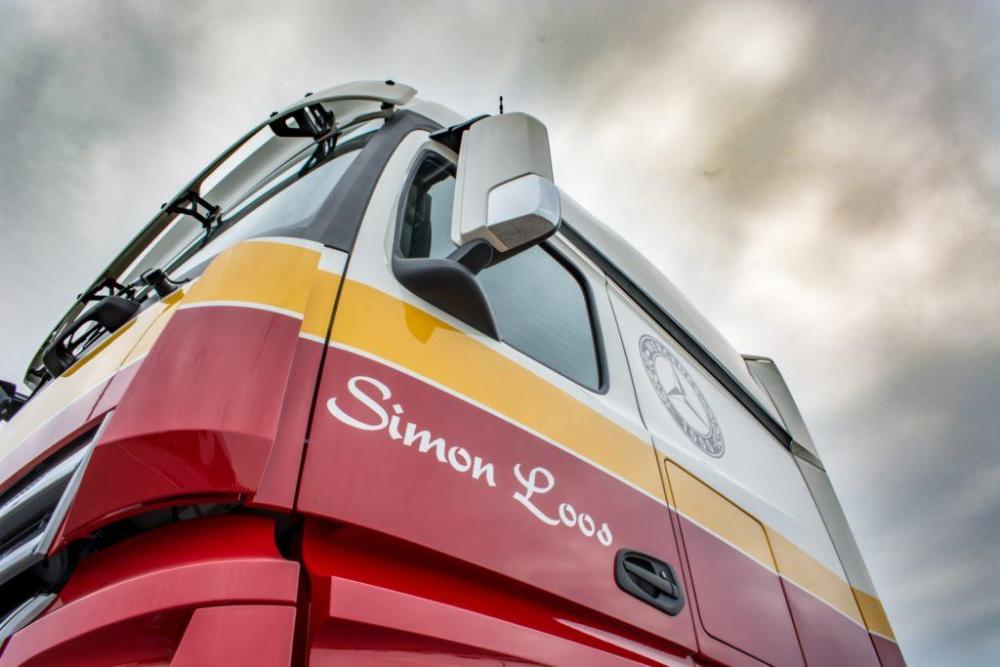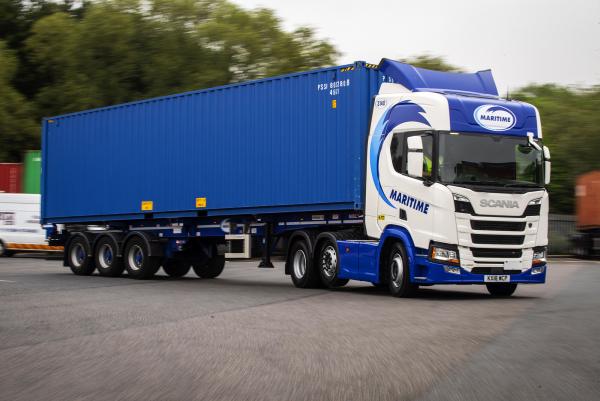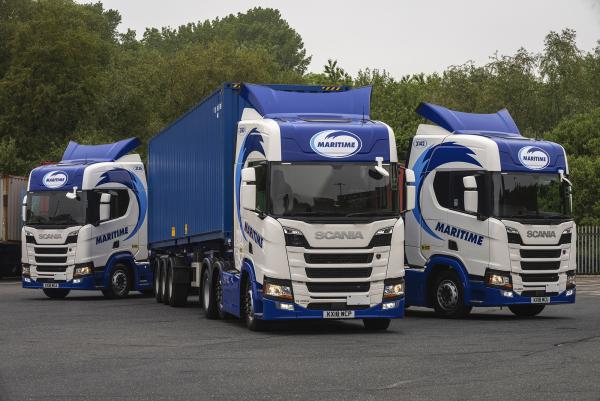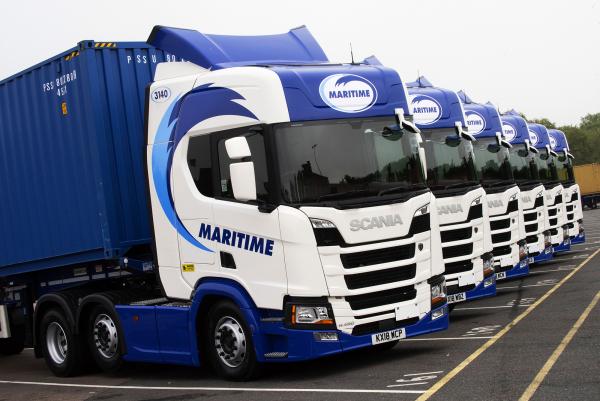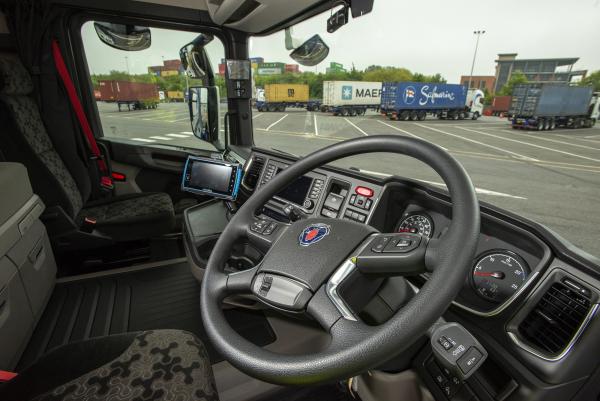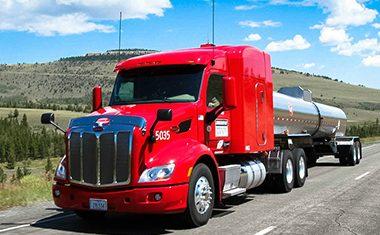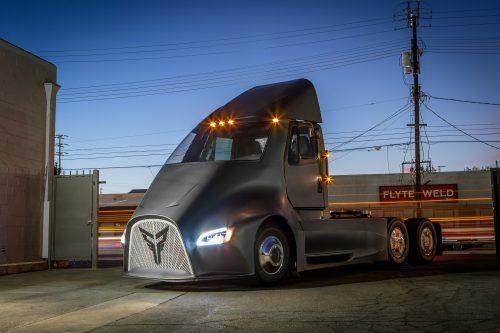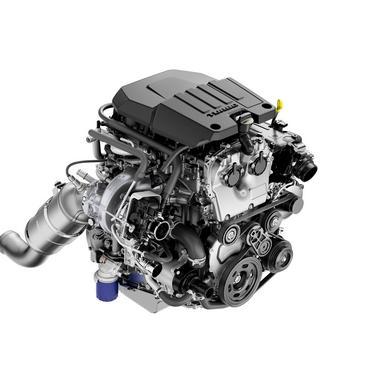
kscarbel2
Moderator-
Posts
18,855 -
Joined
-
Days Won
114
Content Type
Profiles
Forums
Gallery
Events
Blogs
BMT Wiki
Collections
Store
Everything posted by kscarbel2
-
Ford unveils new Transit skeletal chassis cab
kscarbel2 replied to kscarbel2's topic in Trucking News
New Ford Transit Skeletal Chassis Cab Delivers Low Load Floor for Easier Deliveries and 200 kg Additional Payload Ford of Europe Press Release / July 27, 2018 New Transit chassis cab derivative with a special low-height chassis is ideal for conversions requiring a low load floor for easy access Skeletal chassis also delivers 200 kg weight saving over standard chassis cab for enhanced payload and reduced cost of ownership Transit skeletal chassis cab is available to order now from Ford’s network of 950 Transit Centres across Europe COLOGNE, Germany – Ford is introducing a new Transit skeletal chassis cab derivative that provides commercial vehicle customers with a versatile low-height platform for a wide variety of body conversions – ideal for applications ranging from general delivery and distribution to removals. Available to order now from Ford’s European network of Transit Centres, the new skeletal Transit offers a chassis height that is 100 mm lower than the standard front-wheel drive chassis cab model, delivering easier access to the load floor with a lower step height, and removing the need for a separate tail lift. With a 200 kg weight reduction compared to the equivalent chassis cab, the optimised design of the skeletal chassis also provides operators with a significant payload advantage – particularly in combination with lightweight body conversions – in addition to the potential for enhanced fuel efficiency. The skeletal chassis derivative will build on the success of the Transit two-tonne model, which continues to generate increased demand in Europe. The Transit has achieved sales of 52,100 during year-to-date June 2018, a 13 per cent increase over the previous year. “Ford’s Transit is already legendary for its huge range of body styles, drivelines and size variants, and this new model takes our offering a significant step further,” said Hans Schep, general manager, Commercial Vehicles, Ford of Europe. “The new Transit skeletal chassis opens up exciting new opportunities for grocery delivery vehicles and other low-floor body conversions where ease of access is paramount.” The skeletal chassis model is based on a front-wheel drive Transit platform, and features an open-backed cab design that supports easy walk-through from the cab to the load space of the converted body. Customers can specify a choice of three different wheelbase lengths to suit a variety of body conversions, with a wide-track rear axle for the longest variant and an optional wide-track rear axle for the 2 shorter variants. All versions offer a gross vehicle mass of 3.5 tonnes. The Transit skeletal chassis derivative is offered with Ford’s powerful and fuel efficient 2.0litre EcoBlue diesel engine in 130 PS or 170 PS outputs, paired with a standard six-speed manual transmission.* Customers can also choose a six-speed automatic transmission, ideally suited to urban delivery applications. # # # * Officially homologated fuel-efficiency and CO2 emission figures will vary according to customer-derived specification The declared Fuel/Energy Consumptions, CO2 emissions and electric range are measured according to the technical requirements and specifications of the European Regulations (EC) 715/2007 and (EC) 692/2008 as last amended. Fuel consumption and CO2 emissions are specified for a vehicle variant and not for a single car. The applied standard test procedure enables comparison between different vehicle types and different manufacturers. In addition to the fuel-efficiency of a car, driving behaviour as well as other non-technical factors play a role in determining a car's fuel/energy consumption, CO2 emissions and electric range. CO2 is the main greenhouse gas responsible for global warming. From 1 September 2017, certain new vehicles will be type-approved using the World Harmonised Light Vehicle Test Procedure (WLTP) according (EU) 2017/1151 as last amended, which is a new, more realistic test procedure for measuring fuel consumption and CO2 emissions. From 1 September 2018 the WLTP will fully replace the New European Drive Cycle (NEDC), which is the current test procedure. During NEDC Phase-out, WLTP fuel consumption and CO2 emissions are being correlated back to NEDC. There will be some variance to the previous fuel economy and emissions as some elements of the tests have altered i.e., the same car might have different fuel consumption and CO2 emissions. About Ford Motor Company Ford Motor Company is a global company based in Dearborn, Michigan. The company designs, manufactures, markets and services a full line of Ford cars, trucks, SUVs, electrified vehicles and Lincoln luxury vehicles, provides financial services through Ford Motor Credit Company and is pursuing leadership positions in electrification, autonomous vehicles and mobility solutions. Ford employs approximately 202,000 people worldwide. For more information regarding Ford, its products and Ford Motor Credit Company, please visit www.corporate.ford.com. Ford of Europe is responsible for producing, selling and servicing Ford brand vehicles in 50 individual markets and employs approximately 54,000 employees at its wholly owned facilities and approximately 69,000 people when joint ventures and unconsolidated businesses are included. In addition to Ford Motor Credit Company, Ford Europe operations include Ford Customer Service Division and 24 manufacturing facilities (16 wholly owned or consolidated joint venture facilities and eight unconsolidated joint venture facilities). The first Ford cars were shipped to Europe in 1903 – the same year Ford Motor Company was founded. European production started in 1911. . -
Ford unveils new Transit skeletal chassis cab
kscarbel2 replied to kscarbel2's topic in Trucking News
You see Bob, they get the latest 2.0 litre diesel, which is all one needs, while we are forced to buy the thirstier 3.2-litre diesel. -
Land Line (OOIDA) / July 31, 2018 Paccar is recalling more than 3,000 Kenworth and Peterbilt trucks with model years ranging from 2015 to 2018. Affected trucks have an issue with the anti-lock brake system. According to a National Highway Traffic Safety Administration recall document, seven models of Kenworth and Peterbilt trucks have an issue with the ABS warning light. If the ABS loses battery or ignition power to the controller, the dash warning light for the ABS may not illuminate to warn the driver of the loss of ABS. All affected Kenworth trucks are model year 2015-18, while all Peterbilt trucks are model year 2017-18: Kenworth T660 Kenworth T680 Kenworth T800 Kenworth T880 Kenworth W900 Peterbilt 567 Peterbilt 579 Paccar will notify owners of affected trucks. Dealers will update the software free of charge. Recalls are expected to begin July 24. For questions, call Peterbilt customer service at 918-259-3258 or Kenworth customer service at 425-828-5000. NHTSA’s recall number is 18V-368.
-
Australia Extends Military Trucks Order Defense Update / July 25, 2018 The Australian Defense Forces (ADF) is extending the current LAND 121 Phase 3B Project to run through 2024. Under the new program – Land 121 Phase 5B – the Australian subsidiary of German-based Rheinmetall Man Military Vehicles (RMMV) will supply more than a thousand logistical vehicles, and 800 payload modules and trailers, to the Australian Defense Forces (ADF) between 2019 and 2024 under a contract worth a total of A$1.4 billion. Under the LAND 121 Phase 3B program, RMMVA is currently delivering 2,536 protected and unprotected military logistic trucks, and 3,858 locally produced trailers and payload modules from its Brisbane-based integration facility. The new order will be an addition to that program. .
-
Transport Engineer / July 31, 2018 Ford has unveiled a new Transit skeletal chassis cab with a 100mm (3.94 inches) lower chassis height than its standard model. Available to order now, the new chassis is 200kg (441lb) lighter and can be fitted with a range of body conversions – ideal, says Ford, for applications ranging from general delivery and distribution to removals. Based on a front-wheel drive Transit platform, it features an open-backed cab design and the lower step height removes the need for a separate tail-lift. There are three wheelbase lengths to suit a variety of body conversions, with an optional wide-track rear axle for the two shorter variants. All versions offer a gross vehicle mass of 3.5 metric tonnes (7,716lb). The Transit skeletal chassis derivative is offered with the 2.0‑litre EcoBlue diesel engine in 130bhp or 170bhp outputs, paired with a standard six-speed manual transmission. Customers can also choose a six-speed automatic transmission, ideally suited to urban delivery applications. “The new Transit skeletal chassis opens up exciting new opportunities for grocery delivery vehicles and other low-floor body conversions where ease of access is paramount,” says Hans Schep, general manager for commercial vehicles at Ford of Europe. .
-
Heavy Duty Trucking (HDT) / August 1, 2018 Isuzu Commercial Truck of America has announced that the 50,000th gasoline-powered Isuzu N-Series truck rolled off the assembly line in Charlotte, Michigan on August 1. It was a new milestone for the truck maker that first began assembly of the gas-powered N-Series at Spartan Motors in April 2011. “We anticipated the demand for gasoline-engine low-cab-forward trucks over seven years ago, and the assembly of our 50,000th truck proves that our instincts were correct,” said Shaun Skinner, president of Isuzu Commercial Truck of America. In N-Series gas-powered trucks feature a Vortec 6.0 liter V8 engine that produces 297 horsepower and 372 lbs.-ft. of torque. The engine is mated to a six-speed automatic transmission with double overdrive and lock-up torque converter to improve both fuel economy and performance.There is also an optional version of the engine that can be converted to run on either compressed natural gas or propane. “We are proud to offer our gas-powered N-Series truck in a wide range of configurations to meet our customers’ needs,” said Skinner. “And together with our dealerships and Spartan Motors, we’re looking forward to the next 50,000.” .
-
Ford set a new 52-week low of $9.82 today on volume of 41 million, but it needs to fall below $7 before it can be viewed as a bargain buying opportunity given the lack of visibility and solid management.
-
Mercedes-Benz MAN DAF Scania Volvo Renault Iveco When Ford sold the Transcontinental, the American truckmaker was on the list as well. Now, Ford is back. Otosan is committed to being a world player, and Bill Ford is behind them. He understands how committed these guys are.
-
Jay Leno's Garage - 2018 Triumph Bonneville Speedmaster
kscarbel2 replied to kscarbel2's topic in Odds and Ends
-
Netherlands-based logistics provider Simon Loos B.V. has taken delivery of its 1,000th Mercedes-Benz truck in the form of a specially prepared extended cab Actros "Longline". This unique truck is a Mercedes-Benz Actros model 2648 with a 480 horsepower 13-liter 6 cylinder engine. The cab is a hybrid: the front part of the cab is a Mercedes-Benz "Big Space", while the rear is a "Giga Space". This combination is the only one in the world! The inside of the cab is no less special. A luxurious interior features spacious sofas, flat-screen TV, microwave, refrigerator and high-end music system. After a hard days work, a spacious bed is awaiting. Of course, beautifully stitched leather is throughout the interior. This special edition Actros will operate with our bulk transport division. Curious how the unique cab looks inside? Experience it in the virtual tour at simonloos.nl/1000. .
-
- 1
-

-
Yes, per Ford-Otosan.
-
For now, the narrower last generation Ford Cargo cab remains in production for vocational. American operators and their accountants focused on profitability would smile if they could get their hands on this product. .
-
Scania Group Press Release / July 31, 2018 Following comparative study, UK haulier orders 200 Scania trucks. UK multi-modal specialist Maritime Transport has placed its biggest single order yet with one manufacturer. A leading combination of whole life cost, impressive fuel economy and driver acceptance prompted Maritime Transport to order 200 new generation Scania R 450 tractor units. Whole life cost is key to the decision-making-process at Maritime, with fuel consumption being the biggest weighted element in the mix. It has been one year since Maritime started operating the first five new generation Scania trucks and although it is still early days in the 5-year life cycle, Scania has already shown a fuel advantage in the fleet. Track trial confirms superiority Fleet Director, Stuart Wardlaw explains, “Our work can be so varied that usually comparing a vehicle’s fuel performance to another is difficult. To allow us to make an informed decision we undertook a track trial with the latest products across our fleet. As part of this, we eliminated as many variables as possible, such as container size, load weight and route. When it came to fuel economy Scania outperformed the other brand.” “This alongside all other factors of the whole life cost of the vehicles was the deciding factor when placing our order for the 200 Scania R-series.” Specification of the truck itself is important to Maritime to ensure a certain standard of driver welfare, especially where sometimes on-road facilities are not up-to-scratch. The spacious R cabs, which are fitted with fridges and microwave ovens, provide both a comfortable working and living space for their drivers. “From our perspective, when they have got their vehicles we want our drivers to have access to everything they could need – space, storage and home comforts,” comments Wardlaw. Better performance linked to vehicle Keeping their drivers happy is two-fold for Maritime. The company believes that not only will it impact retention but also improve the vehicles’ performance. As Wardlaw puts it, “A driver’s acceptance of a vehicle has a direct link to their behaviour and performance. When they are happy with the vehicle they are driving, we believe they will drive more economically and safely.” As a growing business, Maritime utilises staff feedback to shape future decisions. The feedback from drivers on the new generation Scania trucks has been positive. “It really is a great truck. The overall vision of your surroundings is brilliant, which gives you so much more confidence on the road. The drive is smooth, quiet and responsive and due to the interior design, you can get to everything without taking your hands off the steering wheel. Not only can you do the job, but do so in style and comfort too,” says Maritime driver Andy Parsons. Maritime, which was established in 2001, has a fleet of 1,200 trucks and is one of the largest privately-owned multi-modal transport businesses in the UK. .
-
Uber Shutters Autonomous Truck Business Division Heavy Duty Trucking (HDT) / July 31, 2018 Uber is shuttering its autonomous truck research division. At least for now. That’s the word that came late on July 30 about the San Francisco-based tech company, which is ending research on autonomous trucks in order to focus on self-driving cars. Uber acquired its autonomous truck business from startup Otto almost two years ago in a move that was widely considered controversial and, at times, proved to be contentious. The story broke when online technology journal TechCrunch reported on an email from Eric Meyhofer, head of Uber Advanced Technologies group, which stated that, “We recently took the important step of returning to public roads in Pittsburgh, and as we look to continue that momentum, we believe having our entire team’s energy and expertise focused on this effort is the best path forward. “Rather than having two groups working side by side, focused on different vehicle platforms, I want us instead collaborating as one team,” Meyhofer said in an email to employees reviewed by TechCrunch editors. “I know we’re all super proud of what the Trucks team has accomplished, and we continue to see the incredible promise of self-driving technology applied to moving freight across the country. But we believe delivering on self-driving for passenger applications first, and then bringing it to freight applications down the line, is the best path forward. For now, we need the focus of one team, with one clear objective.” The move will not affect the Uber Freight business unit, which uses the company’s location-based, ride-location app technology to connect truckers with available freight. According to TechCrunch, Uber will shut down its San Francisco operations and move employees to Pittsburgh, where its autonomous car research is located. The company said in a statement that it intends to continue to explore autonomous vehicle technology using passenger cars as foundational research units, but will maintain relationships with trucking OEMs as this technology matures. Uber’s autonomous truck efforts have been hampered by controversy and legal battles since the company acquired the business unit from Otto in 2016. The acquisition later became the subject of an intellectual property lawsuit by Google, citing the role of Anthony Levandowski, the co-founder of Otto, who was a head engineer at Waymo, Google’s self-driving car spinoff, before leaving to concentrate on the new company. Waymo accused Levandowski of taking trade secrets, in the form of photos, schematics, and emails, with him and providing them to Uber. The lawsuit eventually contributed to the resignation of Travis Kalanick, co-founder of Uber, as CEO in 2017. Uber denies that it ever possessed any of the intellectual property, however, it agreed to settle the suit in February by paying Waymo approximately $245 million, and by promising to never use any of Waymo’s confidential information in any of its products. Lawsuits weren’t the only forces working against Uber’s autonomous truck research. In March, an Uber autonomous research vehicle was involved in a fatal accident in Tempe, Arizona., resulting in negative press coverage of autonomous vehicle research and a temporary suspension of tests on public roads pending a review of safety procedures. The company’s decision to suspend research into autonomous vehicles comes a week after the company restarted testing its passenger cars on public roads in Pittsburgh. Currently, the company is running and evaluating self-driving Volvo XC90 vehicles. According to Uber, the vehicles are only being driven manually by humans and under a new set of safety standards that include real-time monitoring of its test drivers and efforts to beef up simulation.
-
Cummins Emissions Recall Includes Over 500,000 Engines Heavy Duty Trucking (HDT) / July 31, 2018 A voluntary recall affecting more than 500,000 Cummins engines has been initiated after an investigation by the California Air Resources Board (CARB) discovered excess emissions resulting from defective emissions aftertreatment systems. Cummins has worked collaboratively with CARB on the voluntary recall, which the agency stated was the largest such effort for heavy-duty trucks to date. Owners of 2010-2015 model-year vehicles are required to replace the faulty emissions equipment. The trucks will be recalled in two phases. Starting in Aug. 2018, owners of the 500,000 affected vehicles will receive letters with instructions on how to get their catalysts replaced or receive reimbursement for the cost of replacement. The second phase begins in March 2019. It is required for vehicle owners to replace the catalyst in order to renew a California DMV registration on most engine families. It was discovered that the selective catalytic reduction systems were defective after excess emissions were detected through CARB’s Heavy Duty In-Use Compliance program. The Cummins recall is the first major recall to result from the program, in which vehicles are equipped with Portable Emissions measurement Systems to measure truck emissions while operating under typical demands and conditions. During testing, some of the Cummins engines revealed higher than expected emissions of nitrogen oxides. This led more comprehensive testing by CARB that confirmed the cause as a defective SCR. The same problem was found in about 60 “engine families” under the Cummins name found in a wide range of vehicles, from large commercial trucks, to larger pickup trucks, and some buses. Cummins also conducted its own testing to confirm the failures and agreed to institute a voluntary recall to replace the catalysts. “Our new heavy-duty in-use compliance program ensures that heavy-duty and other trucks already in operation meet the required emissions standards both in the lab and on the road,” said Mary D. Nichols, CARB chair. “Our portable testing equipment tells us exactly how clean a truck is when it’s actually operating in the real world: pulling a full load and driving on roads and through neighborhoods where people live.” The cause of the problem was purely mechanical, according to CARB, and was the result of faster-than-expected degradation of the catalyst. The degraded catalyst issue is not a safety risk and does not affect current model year Cummins engine families. Following the recall, CARB and EPA will work together to ensure that the affected vehicles will meet all emissions standards.
-
Matt Cole, Commercial Carrier Journal (CCJ) / July 31, 2018 Groendyke Transport (No. 106 on the CCJ Top 250) is petitioning the Federal Motor Carrier Safety Administration to allow it to use pulsating brake lamps in addition to steady burning brake lights. In its application, the Oklahoma-based hazmat tanker fleet says it assessed “what it could do to prevent other drivers from rear ending Groendyke trailers” and decided that increasing visibility would “be an efficient means to prevent rear ending accidents.” The company says it then searched for ways to grab the attention of other drivers faster. The request would allow the company to install an amber brake-activated pulsating light to the upper center portion of its trailers. Groendyke’s application states that research shows that pulsating brake lights in addition to steady burning red brake lights improves visibility and reduces accidents. The company also cites studies by the National Highway Traffic Safety Administration on rear-end crashes, which indicates, according to Groendyke, that drivers are alerted faster when a pulsating brake lamp draws their attention. In a study of its own in which the company added pulsating brake lights to nearly half of its 1,440 trailers, Groendyke found that the frequency of rear-end collisions dropped by 33.7 percent on trailers with the lights compared to those without. FMCSA is requesting public comment on the request, which can be made here through Aug. 29. .
-
James Jaillet, Commercial Carrier Journal (CCJ) / July 31, 2018 Cummins has instituted a voluntary recall of roughly 500,000 model-year 2010-2015 engines, according to an announcement from the U.S. EPA. The recall involves faulty emissions systems components that cause the engines to fall out of compliance with federal emissions regulations. The trucks and engines under the voluntary recall have seen degradation of their selective catalytic reduction systems, according to financial reports issued by Cummins. SCR systems are the exhaust aftertreatment components that use diesel exhaust fluid to curb emissions of nitrogen oxides and greenhouse gases. All manufacturers of engines for Class 8 trucks use SCR and DEF in their emissions-control systems. Engine makers adopted thetechnology in 2010 to meet that year’s emissions hurdles. In financial reports issued for the 2017 fiscal year and for the first quarter of 2018, Cummins noted that the EPA and the California Air Resources Board had pulled “certain pre-2013 model year engine systems for additional emissions testing” and that “some of these engines failed… tests as a result of degradation of an aftertreatment component.” EPA says that Cummins will contact owners of Cummins engines with information on how to have their engines repaired. Cummins said in those reports that it planned to institute a field campaign to address the issue. The engine maker said in its 2017 10-K filing that it had set aside nearly $200 million for the repair campaign. CCJ queried Cummins on multiple occasions in recent weeks asking for information on a potential field campaign and to the extent it would affect fleets who own and operate Cummins engines. CCJ also asked Cummins how many engines were tested by EPA and CARB and how many engines failed the tests due to degradation and whether that percentage could be extrapolated to all Cummins engines in use. Cummins responded to these queries, but did not provide any insight into the questions asked about the emissions-control systems or the field campaign. Cummins spokesperson Jon Mills said in June that the company was working with the EPA and CARB to address the issue. In the company’s 10-Q filing for the first quarter of 2018, Cummins said it “had not yet determined the impact to other model years or engine systems or the percentage of the engine system populations that could be affected.” In its quarterly earnings conference call on Tuesday, July 31, Cummins Chairman and CEO Tom Linebarger said the issue is isolated to 2010-2015 model-year engines and that the company has set aside $181 million for repairs of those engines’ exhaust aftertreatment systems. “We’ve reached agreements with the appropriate regulatory agencies regarding our proposed actions, and we will launch that campaign in phases starting in the third quarter this year and expect to substantially complete the campaign by the end of 2020,” he said. “This issue does not affect any of our current products.”
-
UPS agrees to help develop, test new Thor electric delivery truck Jason Cannon, Commercial Carrier Journal (CCJ) / July 31, 2018 California-based electric truck startup Thor Trucks is about a year from debuting their Class 8 ET-One tractor but their efforts in lighter GVWRs just got a major shot in the arm. Shipping giant UPS announced Tuesday a collaboration with the truck maker to develop and test a fully electric Class 6 delivery truck in Los Angeles, Calif., later this year. Carlton Rose, UPS president of global fleet maintenance and engineering, says UPS will test the medium-duty electric delivery truck as part of its fleet for six months. Testing will include off-road evaluation to address durability, battery capacity, technical integration, engineering and any items found during on-road testing. Depending on the success of the deployment, Rose UPS may make additional purchases of the vehicle. “UPS believes in the future of commercial electric vehicles,” Rose says. “We want to support the research needed to make advances and the companies developing those innovative products. Performance is critical in our fleet. We are excited to get this vehicle on the road to test how it handles routes in and around Los Angeles.” Thor Trucks CEO and co-founder Dakota Semler says the chance to work with UPS is valuable opportunity for his company to gain insight into what it will take to fulfill its mission of getting entire electric fleets on the road. UPS’s is far from a newcomer into the electric truck space. The company already uses electric vehicles and works with a wide array of manufacturers including ARRIVAL, Daimler, Tesla, Thor, Workhorse and others. UPS deploys about 9,300 low-emission vehicles, including all-electric, hybrid electric, hydraulic hybrid, ethanol, compressed natural gas (CNG), liquefied natural gas (LNG) and propane. .
-
They're done a bit differently, simplified a bit, but still look great.
-
GM brings back iconic 1960s Tripower name Richard Truett, Automotive News / July 31, 2018 TRAVERSE CITY, Mich. -- For the first time since the mid-1960s, General Motors will use the Tripower name on an engine. But today's Tripower setup -- due in the next-generation Chevrolet Silverado and GMC Sierra pickups -- means something very different than it did in 1966, the last time a Tripower engine was offered in such cars as the Pontiac GTO. For the new 2.7-liter turbo four-cylinder engine designed specifically for GM's full-size trucks, Tripower will refer to a suite of technologies that boosts horsepower and fuel economy, explained Mike Anderson, executive director of global transmission and electrification hardware engineering. Speaking at the CAR Management Briefing Seminars on Tuesday, Anderson said the new Tripower will encompass: Cylinder deactivation, which shuts off two of the four cylinders at light-load cruising speeds. Active thermal management that can increase or decrease heat in various parts of the engine to speed warm-ups or reduce temperatures in order to keep the engine running longer in its most thermally efficient range. Intake valve lift control, a system that reduces the length the intake valve opens at certain speeds, which helps improve fuel economy under certain drive conditions. GM expects deliveries of the new engine to start after the new trucks are launched this year. It is rated at 310 hp, one of the highest ever for a regular production four-cylinder engine. The new engine also uses an electric water pump, and a new and more efficient turbocharger from BorgWarner. The original Tripower setup referred to the use of three two-barrel carburetors sitting on top of Pontiac's V-8 engines, used in the automaker's high-performance muscle cars. The final version of Pontiac's Tripower engine, a 389-cubic-inch V-8 used in the 1966 GTO, made 360 hp. The arrangement was a less expensive option than fuel injection. Pontiac offered Tripower engines in 1957-66. Pontiac muscle cars with Tripower engines from that era are now highly coveted by collectors, and the Tripower name is one of GM's most revered. .
-
Taro and pineapple.
-
Reuters / July 31, 2018 United Parcel Service said it would partner with a Los Angeles-based company to develop an electric medium-duty delivery truck, as the package delivery company expands its fleet of alternative-fuel vehicles. The truck, developed jointly with electric commercial vehicle startup Thor* Trucks Inc, is expected to be deployed later this year, UPS said on Tuesday. The truck will have a driving range of about 100 miles, with lightweight battery designed and built by Thor. UPS will test the class-6 delivery truck for the first six months, including its battery capacity and technical integration, after which UPS may buy more of these trucks. This will be a part of UPS’s plan of about 9,300 low-emission vehicles, including all-electric, hybrid electric and CNG, to understand which technology works best for some routes. UPS has partnered with Workhorse Group to build an all-new electric delivery van, and also has pre-ordered 125 electric semi-trucks from Tesla Inc. * https://www.bigmacktrucks.com/topic/51984-another-all-electric-class-8-prepares-for-production/?tab=comments#comment-387733
BigMackTrucks.com
BigMackTrucks.com is a support forum for antique, classic and modern Mack Trucks! The forum is owned and maintained by Watt's Truck Center, Inc. an independent, full service Mack dealer. The forums are not affiliated with Mack Trucks, Inc.
Our Vendors and Advertisers
Thank you for your support!


